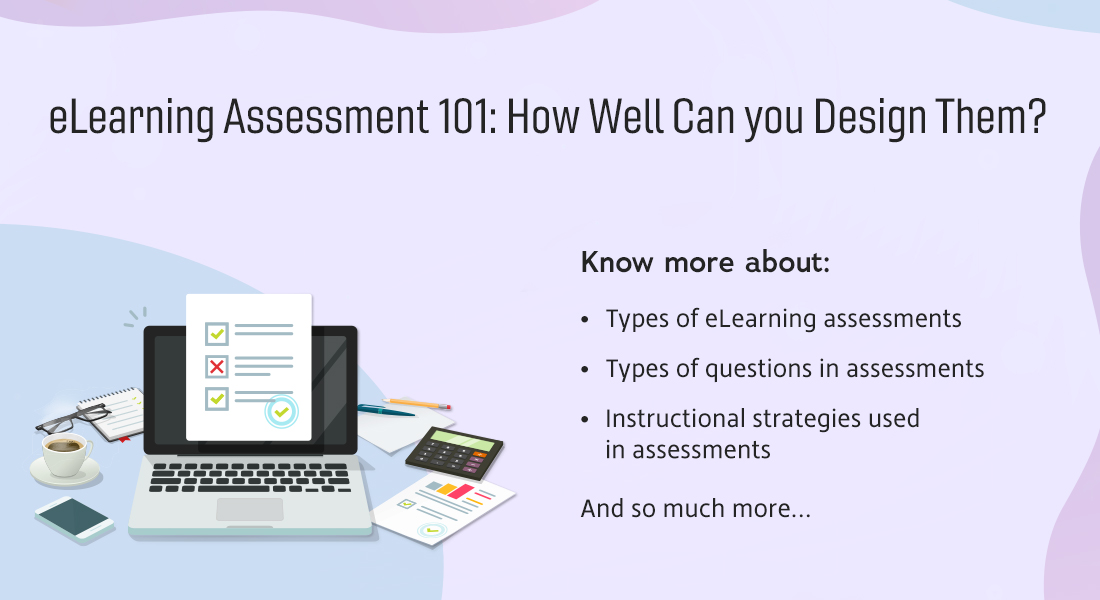The Role of Assessments in Online Training

According to the Loughborough University and Joint Information Systems Committee (JISC), assessments are an important part of learning strategies. Assessments test the learners’ accomplishment of the learning objectives. They are used to strengthen learning as well as evaluate the learners’ comprehension of a course.
→ Download eBook: Instructional Design 101 - A Handy Reference Guide for eLearning Designers
In elearning, assessments are given either at the end of each topic as formative assessments or at the end of the course as summative assessments. Formative assessments are used to monitor and measure the learning achievement after each learning point, whereas summative assessments are used to evaluate and monitor the learners’ level of understanding at the end of the course.
The main differences between formative and summative assessments are shown below:
| Formative Assessments | Summative Assessments | |
| Position | Questions are presented at the end of each unit (learning point) in the course in alignment with the learning objectives. |
|
| Feedback |
|
Feedback or the results will be shown at the end of the quiz. |
| Scores | The scores are not stored. | Scores of the last assessment result are stored (requires a Database on the server). |
| No. of Attempts | Learners can attempt the assessment as many times as they wish. | If the learner quits the assessment halfway, he or she will need to take the assessment again right from the beginning the next time around. |
In addition, the assessment strategy in elearning courses differs depending on the type of training we offer. Let us now see some of the strategies for creating assessments to test learners’ understanding of the subject.

Instructional Design 101
A Handy Reference Guide for eLearning Designers
- eLearning standards
- Streamlined instructional design process
- Effective assessments
- And More!
Product Training
Having strong product knowledge helps your sales personnel recommend right products to the customers. Thus, reinforcing training is important if you want your sales personnel have the complete information about your product wherein they will be able to enhance buying decisions of the customers. Assessments are one of the ways through which we can evaluate the learners’ comprehension about the product.
Provide the learner a quiz to help him check his understanding. In order to evaluate the understanding of the learner, create a scenario-based assessment.
Here is an example of a scenario-based assessment wherein the doctor asks questions regarding the usage of a particular drug, and the sales representative lists both the advantages and disadvantages of that drug.

Software Training
Organizations worldwide are managing their operations with online tools – SAP, HRIS Workday, Service Tools and many more. These tools help global organizations align and sync their operations worldwide with just a click. But, these are not so simple to be adopted by employees. All the employees need to be trained in order to use the software. In elearning we use ‘The Watch, Try Do approach’ which enables holistic learning.

In the final DO step, assessments play a vital role wherein the learner needs to apply the knowledge that he has acquired, remember the steps and do them on his own.
The above example was about software which helps the sales personnel recommend appropriate products based on client requirements. First, the task was explained and shown to the learners in the form of simulations. At the end, in order to test learners’ understanding about the software, they were provided a set of client requirements and asked to come up with a suitable product that meets the client’s requirements with exceptional services.

Compliance Training
Company rules, regulations and guidelines keep changing from time to time. Thus, it becomes necessary for all the employees of an organization to know and understand the regulations that are currently in force at any given time. Assessments support learning as well as assess the learner’s knowledge on the training.
In order to check the learner’s understanding during training, in this example, the learner was presented a situation and then posed a question to test his knowledge.


Hope this was informative. Please share your thoughts and opinions on the same!
Editor’s Note: This post was originally published in March 2010 and has been completely revamped and updated for accuracy and comprehensiveness.




![7 Quick Tips to Frame Effective Learning Objectives for Custom eLearning [Infographic]](https://blog.commlabindia.com/hubfs/blogs/tips-frame-effective-learning-objectives.jpg)
